2003 FORD MUSTANG engine
[x] Cancel search: enginePage 206 of 256
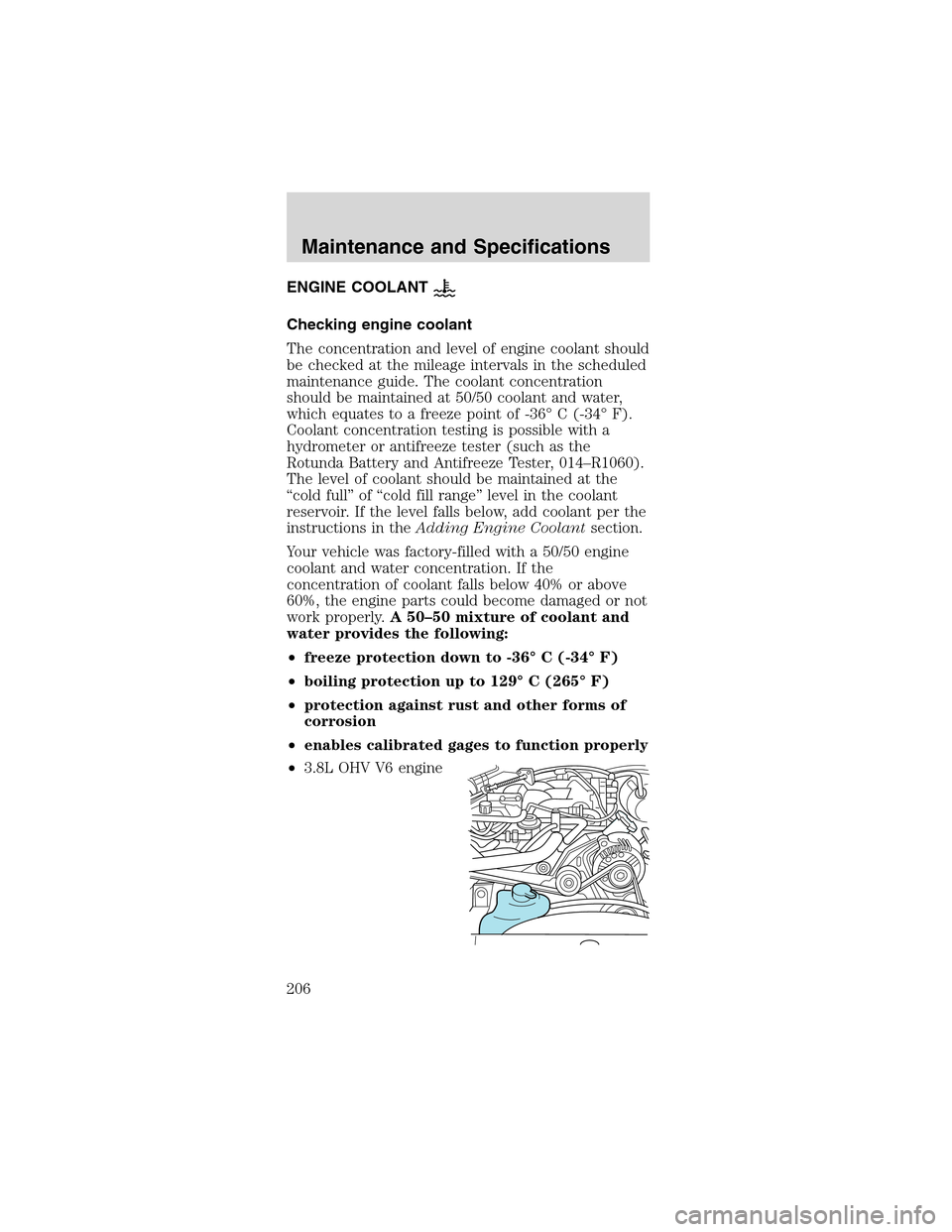
ENGINE COOLANT
Checking engine coolant
The concentration and level of engine coolant should
be checked at the mileage intervals in the scheduled
maintenance guide. The coolant concentration
should be maintained at 50/50 coolant and water,
which equates to a freeze point of -36°C (-34°F).
Coolant concentration testing is possible with a
hydrometer or antifreeze tester (such as the
Rotunda Battery and Antifreeze Tester, 014–R1060).
The level of coolant should be maintained at the
“cold full”of“cold fill range”level in the coolant
reservoir. If the level falls below, add coolant per the
instructions in theAdding Engine Coolantsection.
Your vehicle was factory-filled with a 50/50 engine
coolant and water concentration. If the
concentration of coolant falls below 40% or above
60%, the engine parts could become damaged or not
work properly.A50–50 mixture of coolant and
water provides the following:
•freeze protection down to -36°C (-34°F)
•boiling protection up to 129°C (265°F)
•protection against rust and other forms of
corrosion
•enables calibrated gages to function properly
•3.8L OHV V6 engine
Maintenance and Specifications
206
Page 207 of 256

•4.6L SOHC V8
engine
When the engine is cold, check the level of the
engine coolant in the reservoir.
•The engine coolant should be at the“cold fill
level”as listed on the engine coolant reservoir.
•Refer to the scheduled maintenance guide for
service interval schedules.
•Be sure to read and understandPrecautions
when servicing your vehiclein this chapter.
If the engine coolant has not been checked at the
recommended interval, the engine coolant reservoir
may become low or empty. If the reservoir is low or
empty, add engine coolant to the reservoir. Refer to
Adding engine coolantin this chapter.
Note:Automotive fluids are not interchangeable; do
not use engine coolant, antifreeze or windshield
washer fluid outside of its specified function and
vehicle location.
Adding engine coolant
When adding coolant, make sure it is a 50/50
mixture of engine coolant and distilled water. Add
the mixture to the coolant reservoir,when the
engine is cool, until the appropriate fill level is
obtained.
Do not add engine coolant when the engine
is hot. Steam and scalding liquids released
from a hot cooling system can burn you badly.
Also, you can be burned if you spill coolant on hot
engine parts.
Maintenance and Specifications
207
Page 208 of 256
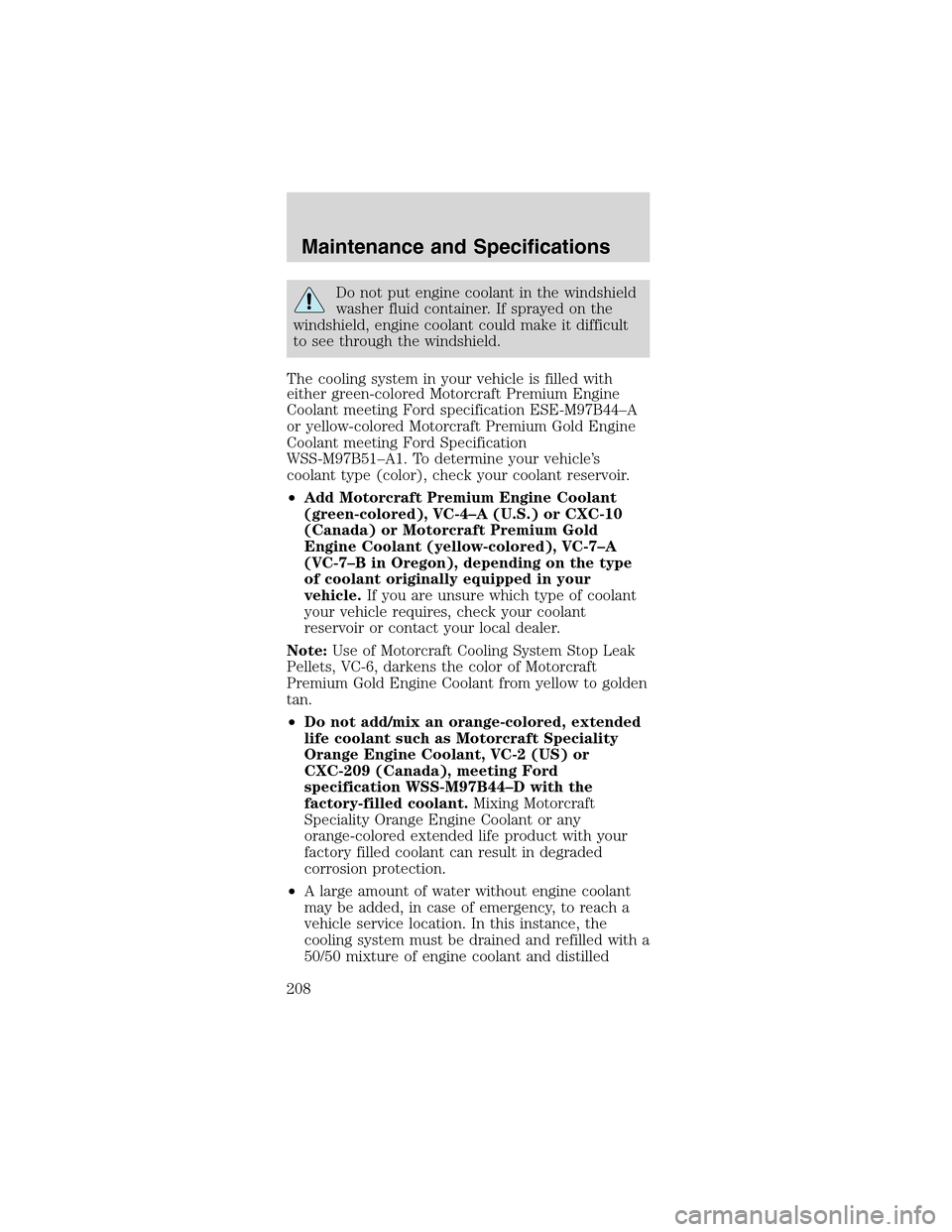
Do not put engine coolant in the windshield
washer fluid container. If sprayed on the
windshield, engine coolant could make it difficult
to see through the windshield.
The cooling system in your vehicle is filled with
either green-colored Motorcraft Premium Engine
Coolant meeting Ford specification ESE-M97B44–A
or yellow-colored Motorcraft Premium Gold Engine
Coolant meeting Ford Specification
WSS-M97B51–A1. To determine your vehicle’s
coolant type (color), check your coolant reservoir.
•Add Motorcraft Premium Engine Coolant
(green-colored), VC-4–A (U.S.) or CXC-10
(Canada) or Motorcraft Premium Gold
Engine Coolant (yellow-colored), VC-7–A
(VC-7–B in Oregon), depending on the type
of coolant originally equipped in your
vehicle.If you are unsure which type of coolant
your vehicle requires, check your coolant
reservoir or contact your local dealer.
Note:Use of Motorcraft Cooling System Stop Leak
Pellets, VC-6, darkens the color of Motorcraft
Premium Gold Engine Coolant from yellow to golden
tan.
•Do not add/mix an orange-colored, extended
life coolant such as Motorcraft Speciality
Orange Engine Coolant, VC-2 (US) or
CXC-209 (Canada), meeting Ford
specification WSS-M97B44–Dwiththe
factory-filled coolant.Mixing Motorcraft
Speciality Orange Engine Coolant or any
orange-colored extended life product with your
factory filled coolant can result in degraded
corrosion protection.
•A large amount of water without engine coolant
may be added, in case of emergency, to reach a
vehicle service location. In this instance, the
cooling system must be drained and refilled with a
50/50 mixture of engine coolant and distilled
Maintenance and Specifications
208
Page 209 of 256
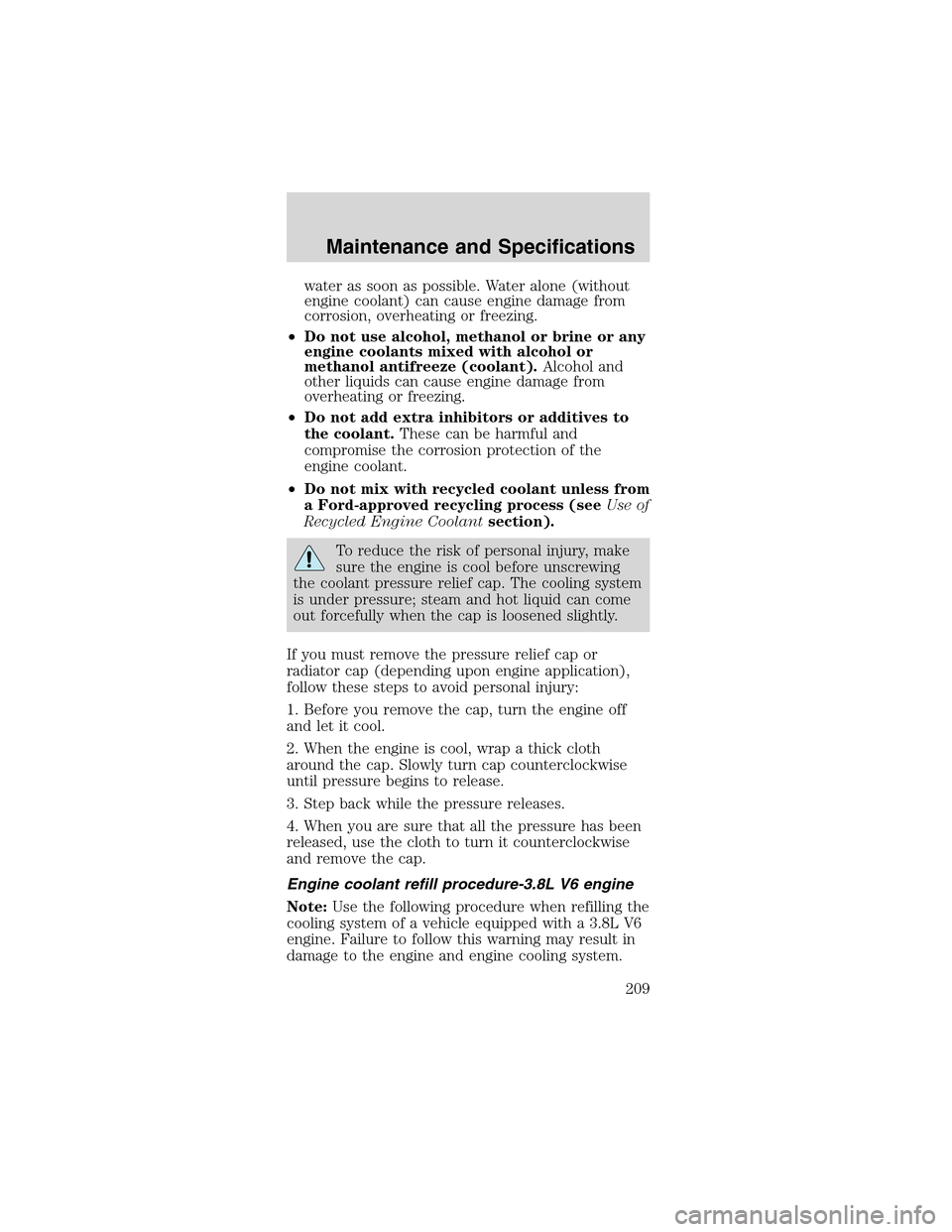
water as soon as possible. Water alone (without
engine coolant) can cause engine damage from
corrosion, overheating or freezing.
•Do not use alcohol, methanol or brine or any
engine coolants mixed with alcohol or
methanol antifreeze (coolant).Alcohol and
other liquids can cause engine damage from
overheating or freezing.
•Do not add extra inhibitors or additives to
the coolant.These can be harmful and
compromise the corrosion protection of the
engine coolant.
•Do not mix with recycled coolant unless from
a Ford-approved recycling process (seeUse of
Recycled Engine Coolantsection).
To reduce the risk of personal injury, make
sure the engine is cool before unscrewing
the coolant pressure relief cap. The cooling system
is under pressure; steam and hot liquid can come
out forcefully when the cap is loosened slightly.
If you must remove the pressure relief cap or
radiator cap (depending upon engine application),
follow these steps to avoid personal injury:
1. Before you remove the cap, turn the engine off
and let it cool.
2. When the engine is cool, wrap a thick cloth
around the cap. Slowly turn cap counterclockwise
until pressure begins to release.
3. Step back while the pressure releases.
4. When you are sure that all the pressure has been
released, use the cloth to turn it counterclockwise
and remove the cap.
Engine coolant refill procedure-3.8L V6 engine
Note:Use the following procedure when refilling the
cooling system of a vehicle equipped with a 3.8L V6
engine. Failure to follow this warning may result in
damage to the engine and engine cooling system.
Maintenance and Specifications
209
Page 210 of 256
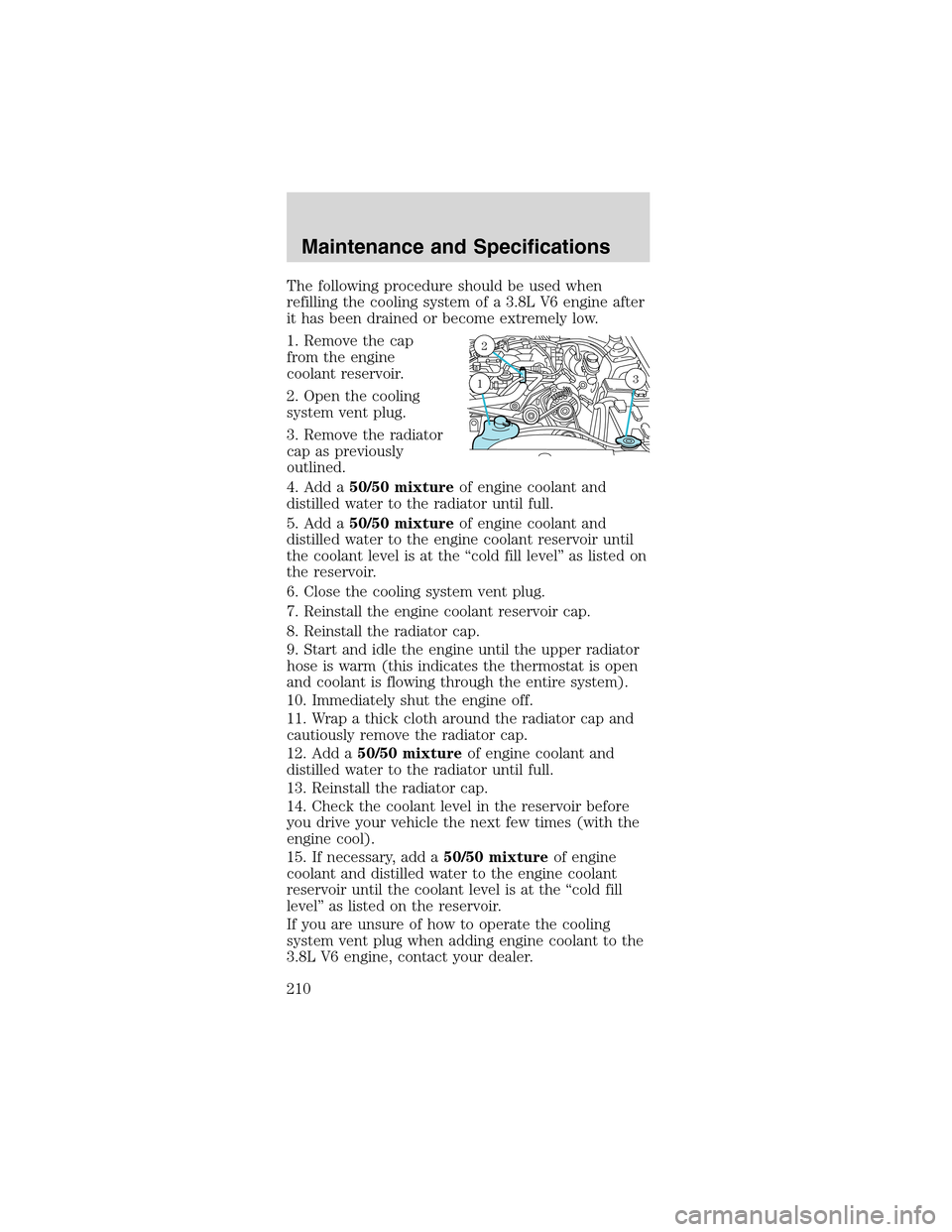
The following procedure should be used when
refilling the cooling system of a 3.8L V6 engine after
it has been drained or become extremely low.
1. Remove the cap
from the engine
coolant reservoir.
2. Open the cooling
system vent plug.
3. Remove the radiator
cap as previously
outlined.
4. Add a50/50 mixtureof engine coolant and
distilled water to the radiator until full.
5. Add a50/50 mixtureof engine coolant and
distilled water to the engine coolant reservoir until
the coolant level is at the“cold fill level”as listed on
the reservoir.
6. Close the cooling system vent plug.
7. Reinstall the engine coolant reservoir cap.
8. Reinstall the radiator cap.
9. Start and idle the engine until the upper radiator
hose is warm (this indicates the thermostat is open
and coolant is flowing through the entire system).
10. Immediately shut the engine off.
11. Wrap a thick cloth around the radiator cap and
cautiously remove the radiator cap.
12. Add a50/50 mixtureof engine coolant and
distilled water to the radiator until full.
13. Reinstall the radiator cap.
14. Check the coolant level in the reservoir before
you drive your vehicle the next few times (with the
engine cool).
15. If necessary, add a50/50 mixtureof engine
coolant and distilled water to the engine coolant
reservoir until the coolant level is at the“cold fill
level”as listed on the reservoir.
If you are unsure of how to operate the cooling
system vent plug when adding engine coolant to the
3.8L V6 engine, contact your dealer.
2
31
Maintenance and Specifications
210
Page 211 of 256
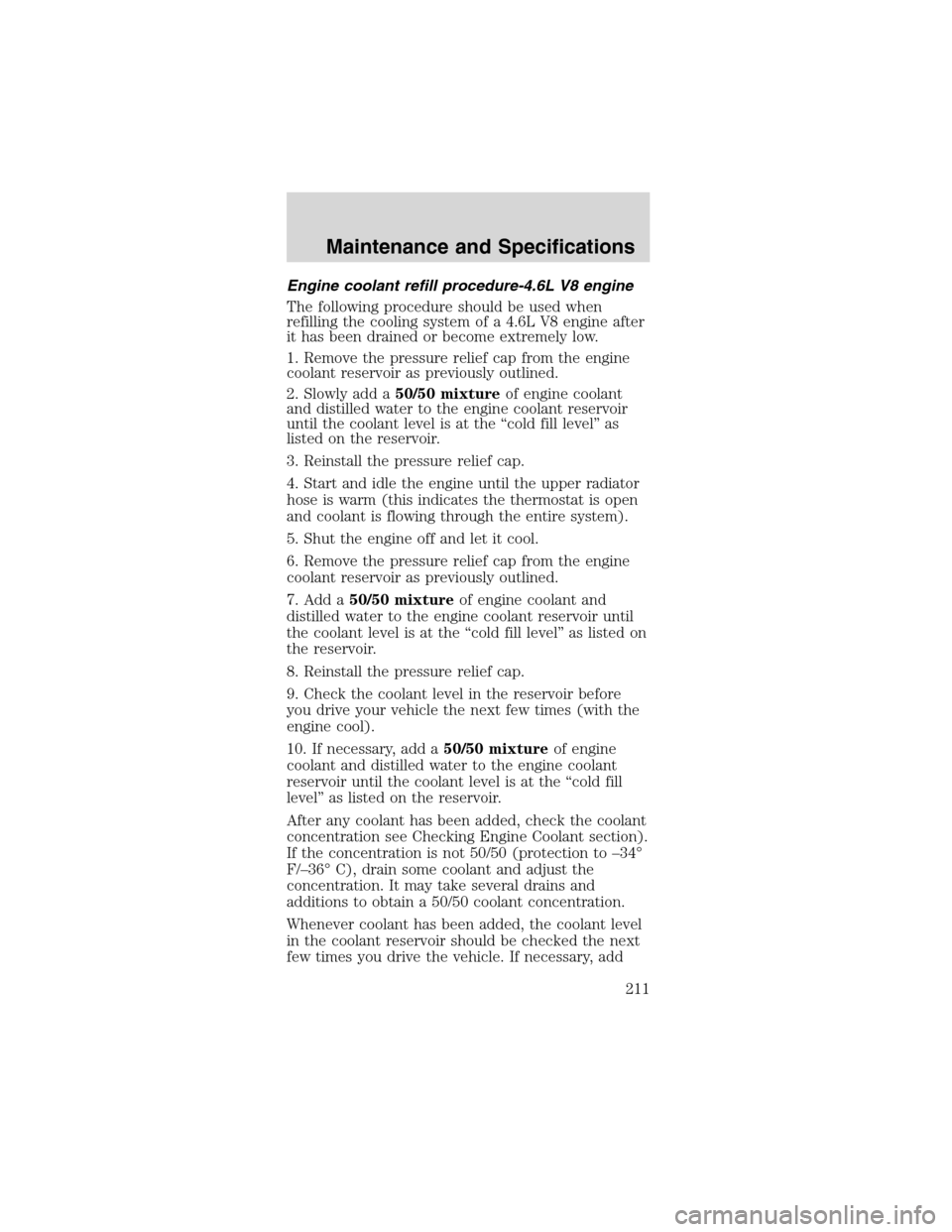
Engine coolant refill procedure-4.6L V8 engine
The following procedure should be used when
refilling the cooling system of a 4.6L V8 engine after
it has been drained or become extremely low.
1. Remove the pressure relief cap from the engine
coolant reservoir as previously outlined.
2. Slowly add a50/50 mixtureof engine coolant
and distilled water to the engine coolant reservoir
until the coolant level is at the“cold fill level”as
listed on the reservoir.
3. Reinstall the pressure relief cap.
4. Start and idle the engine until the upper radiator
hose is warm (this indicates the thermostat is open
and coolant is flowing through the entire system).
5. Shut the engine off and let it cool.
6. Remove the pressure relief cap from the engine
coolant reservoir as previously outlined.
7. Add a50/50 mixtureof engine coolant and
distilled water to the engine coolant reservoir until
the coolant level is at the“cold fill level”as listed on
the reservoir.
8. Reinstall the pressure relief cap.
9. Check the coolant level in the reservoir before
you drive your vehicle the next few times (with the
engine cool).
10. If necessary, add a50/50 mixtureof engine
coolant and distilled water to the engine coolant
reservoir until the coolant level is at the“cold fill
level”as listed on the reservoir.
After any coolant has been added, check the coolant
concentration see Checking Engine Coolant section).
If the concentration is not 50/50 (protection to–34°
F/–36°C), drain some coolant and adjust the
concentration. It may take several drains and
additions to obtain a 50/50 coolant concentration.
Whenever coolant has been added, the coolant level
in the coolant reservoir should be checked the next
few times you drive the vehicle. If necessary, add
Maintenance and Specifications
211
Page 212 of 256
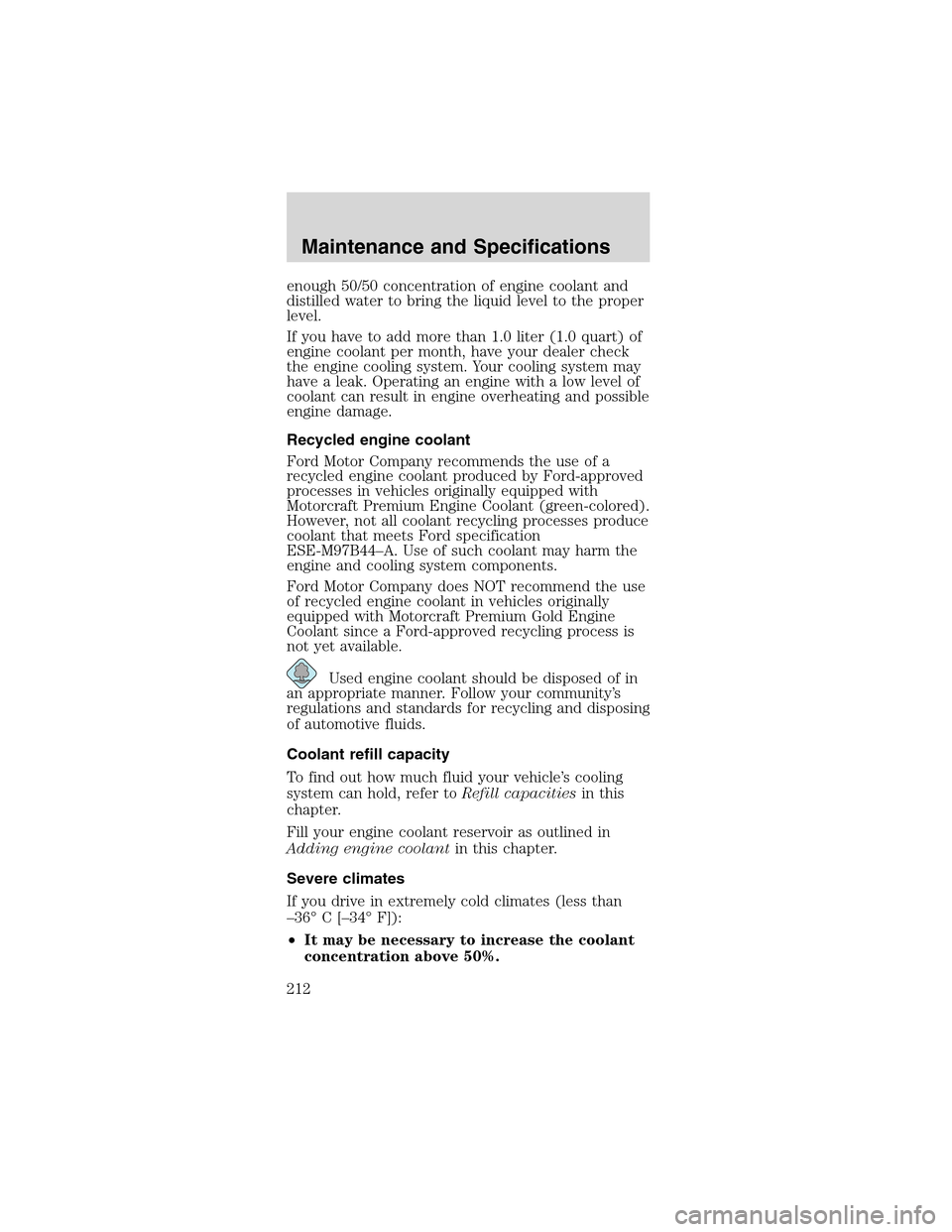
enough 50/50 concentration of engine coolant and
distilled water to bring the liquid level to the proper
level.
If you have to add more than 1.0 liter (1.0 quart) of
engine coolant per month, have your dealer check
the engine cooling system. Your cooling system may
have a leak. Operating an engine with a low level of
coolant can result in engine overheating and possible
engine damage.
Recycled engine coolant
Ford Motor Company recommends the use of a
recycled engine coolant produced by Ford-approved
processes in vehicles originally equipped with
Motorcraft Premium Engine Coolant (green-colored).
However, not all coolant recycling processes produce
coolant that meets Ford specification
ESE-M97B44–A. Use of such coolant may harm the
engine and cooling system components.
Ford Motor Company does NOT recommend the use
of recycled engine coolant in vehicles originally
equipped with Motorcraft Premium Gold Engine
Coolant since a Ford-approved recycling process is
not yet available.
Used engine coolant should be disposed of in
an appropriate manner. Follow your community’s
regulations and standards for recycling and disposing
of automotive fluids.
Coolant refill capacity
To find out how much fluid your vehicle’s cooling
system can hold, refer toRefill capacitiesin this
chapter.
Fill your engine coolant reservoir as outlined in
Adding engine coolantin this chapter.
Severe climates
If you drive in extremely cold climates (less than
–36°C[–34°F]):
•It may be necessary to increase the coolant
concentration above 50%.
Maintenance and Specifications
212
Page 213 of 256

•NEVERincreasethe coolant concentration
above 60%.
•Increased engine coolant concentrations
above 60% will decrease the overheat
protection characteristics of the engine
coolant and may cause engine damage.
•Refer to the chart on the coolant container
to ensure the coolant concentration in your
vehicle will provide adequate freeze
protection at the temperatures in which you
drive in the winter months.
If you drive in extremely hot climates:
•It is still necessary to maintain the coolant
concentration above 40%.
•NEVER decrease the coolant concentration
below 40%.
•Decreased engine coolant concentrations
below 40% will decrease the corrosion
protection characteristics of the engine
coolant and may cause engine damage.
•Decreased engine coolant concentrations
below 40% will decrease the freeze
protection characteristics of the engine
coolant and may cause engine damage.
•Refer to the chart on the coolant container
to ensure the coolant concentration in your
vehicle will provide adequate protection at
the temperatures in which you drive.
Vehicles driven year-round in non-extreme climates
should use a 50/50 mixture of engine coolant and
distilled water for optimum cooling system and
engine protection.
Maintenance and Specifications
213